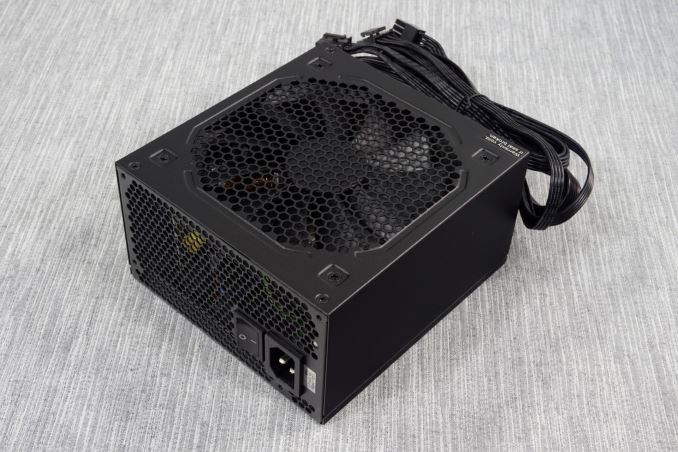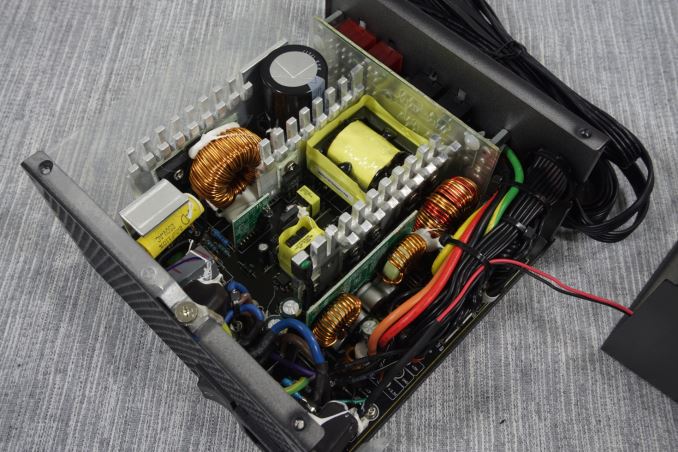The Rosewill Hive 850W PSU Review
by E. Fylladitakis on July 28, 2015 9:00 AM EST- Posted in
- PSUs
- Cases/Cooling/PSUs
- Rosewill
- 850W
External Appearance
Much like with the Photon series, the Hive is hardly any different from a typical black ATX PSU. The only thing that differentiates it from the core design is the fan finger guard, which is not a separate part but a honeycomb pattern punched on the steel chassis itself. Aside from the sticker with the electrical specifications of the PSU at the top of the chassis, there is virtually nothing else that would break the monotony of the black, plain chassis.
This is a semi-modular unit, with some of the cables hardwired and others removable. The connectors for the modular cables can be seen at the front of the chassis, with a basic printed legend indicating which connector corresponds to each cable. Do note that the connectors for the PCI Express cables are red and the connectors for the 6 pin and 6+2 pin cables are different.
Internal Design
A rather standard, high speed 135 mm fan from Globe is found beneath the honeycomb finger guard of the Hive 850W PSU. The S1352512HH is a sleeve bearing and a maximum speed of 1800 RPM, meaning that at lower speeds it can handle itself well, but at maximum speed it could get awfully loud. Of course, a thermal control circuitry adjusts the speed of the fan according to the load and the temperature of the unit, so we will see how it truly behaves during our testing.
Sirfa is the OEM behind the Rosewill Hive 850W. Although they are not very reputable among enthusiasts, Sirfa is a good OEM and they released several relatively good platforms during the past few years, yet they also faced a couple of mishaps with a certain low-cost platforms. Our sample is based on a slightly modified version of the popular Direct12 Bronze II platform that has been around for a couple of years.
The filtering stage is textbook in design, with four Y capacitors, two X capacitors and two filtering inductors. A small and plain heatsink provides cooling to the main rectifying bridge, while the APFC components are mounted on a long heatsink alongside the edge of the PCB. A very large inductor and a 400V/680μF Rubycon capacitor are the passive PFC components. A half-bridge inversion configuration feeds the main transformer, the output of which is then processed to a single 12V line. The 5V and 3.3V lines are then derived via DC-to-DC conversion circuits.
Despite the presence of the DC-to-DC conversion circuits, the low efficiency transistors prohibit this platform from attaining a better efficiency certification. The electrolytic capacitors and the polymer capacitors on the secondary side are supplied by Teapo and Nippon Chemi-Con respectively. The presence of so many Teapo capacitors is likely to negatively affect the opinion of enthusiasts, as they are not the most reputable supplier. The build quality of the Hive 850W is rather good, albeit the design is dense and a bit messy. A lot of glue has been used to maximize the mechanical strength of the PSU.

























24 Comments
View All Comments
ImSpartacus - Tuesday, July 28, 2015 - link
As a layman, this was a cool review to read. It's often hard to figure out exactly what makes one psu different from another with similar marketing "specs". It's assumed that many are based on a handful of oem's designs, but it can be a challenge to dig that deep. This review presents much of that info up front. No digging necessary. Cool beans.Stuka87 - Tuesday, July 28, 2015 - link
The 12V rail sag is a bit more than I would like. And the fact that its only rated for 40C is really a bummer. Its very common for the inside of a PC case to hit 45-50C, especially in the summer with a few GPU's inside it. Some cases do let you put the PUS in upside down so it sucks in cool air (my own does) but many do not.MamiyaOtaru - Wednesday, July 29, 2015 - link
cases that don't put the PSU at the bottom are an anachronism IMHOAndrewJacksonZA - Tuesday, July 28, 2015 - link
Were these tests done at 110V or 220V?E.Fyll - Tuesday, July 28, 2015 - link
230V/50Hz. It is noted in the pipeline that includes the details of all the equipment and procedures.piasabird - Tuesday, July 28, 2015 - link
How do you know what this means unless you have a few other power supplies as a baseline to draw a comparison. For instance if you had what you considered is the best test results for a power supply, and one or two other the test results might make more sense. You always show comparisons for processors and video cards.Oxford Guy - Wednesday, July 29, 2015 - link
An entire article just for one PSU?doggface - Wednesday, July 29, 2015 - link
Have you been here before. They do this all the time???Oxford Guy - Wednesday, July 29, 2015 - link
It's one thing for a little site to devote an entire article to a bronze PSU and another thing for a big one to do so.Quake - Monday, August 3, 2015 - link
Eh... Anandtech was founded in 1997 and it's one of the biggest enthusiast website. https://en.m.wikipedia.org/wiki/AnandTech